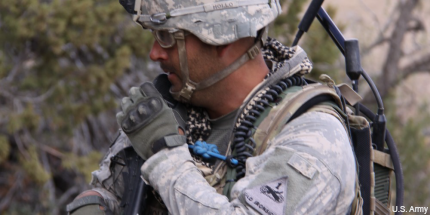Android app quickly connects Army’s tactical radios
ODIN, developed in six months from an open Android framework, could cut the time of aligning radios from days to minutes.

Separate Army units using the latest software-defined radios still can’t talk to each other unless their radios are preset for it. And getting them on the same page—a network adjustment called unit task reorganization—can take days, or even weeks.
The Army is looking to bring that down to three clicks and three minutes with the On Demand Information Network, or ODIN, an app based on the Android operating system.
ODIN, developed by Army engineers in six months, draws on the Joint Battle Command-Platform for situational awareness and could allow radios to be set up quickly for over-the-air mission planning, the Army said.
"This has tremendous power," Lt. Col. Michael Olmstead, product manager for JBC-P, said in a statement. "Even in today's fiscal climate, we know we still need to deliver new capabilities to our soldiers and doing it through apps is a smart way to make investments with what limited resources we have."
The Army is working to give soldiers more flexible, interoperable tactical communications through programs such as the Warfighter Information Network-Tactical and the Common Operating Environment. The idea is to provide an environment closer to what they’re used to with their smartphones.
For building apps such as ODIN, that means working from a standard framework. The Army has developed an open Android architecture called MACE, for Mounted Android Computing Environment, that gives government and industry developers a familiar platform, as well as a trove of commercial Android knowledge to draw on.
Engineers with Project Manager Tactical Radios used MACE to develop a prototype for ODIN. The process that not only makes it easy for the developers but gives soldiers a simple, familiar Android-style app to use.
The MACE framework not only allows for fast development but it makes it possible to reuse existing capabilities, the Army said. For example, engineers using MACE needed only two weeks to adapt the Tactical Ground Reporting (TIGR) information and intelligence system into a TIGR app for the Army’s Nett Warrior devices, which are also Android-based.
ODIN will be tested later this year at the Army’s Network Integration Evaluation 15.1, the next of the semi-annual field tests of its battlefield network.
The Army acknowledges that ODIN won’t bridge every communications gap, but it could take a big step toward simplifying unit task reorganization, which is something units have requested.
"This is simple for the soldiers, easy to build for developers and provides a level of customization that we just haven't had before," said Dan Stroka, lead for the MACE. "The apps are developed once and through MACE are capable of running on multiple hardware platforms at multiple echelons and across multiple networks. It enables simpler, common capabilities for the soldiers, allows the Army to innovate and at the same time converges systems."
NEXT STORY: Navy takes high-bandwidth satcom to the Arctic




